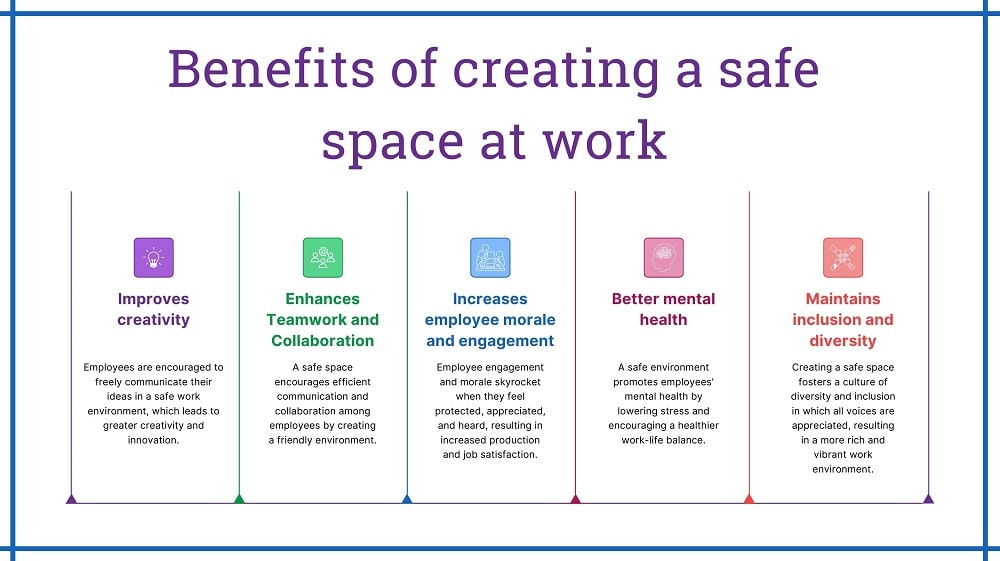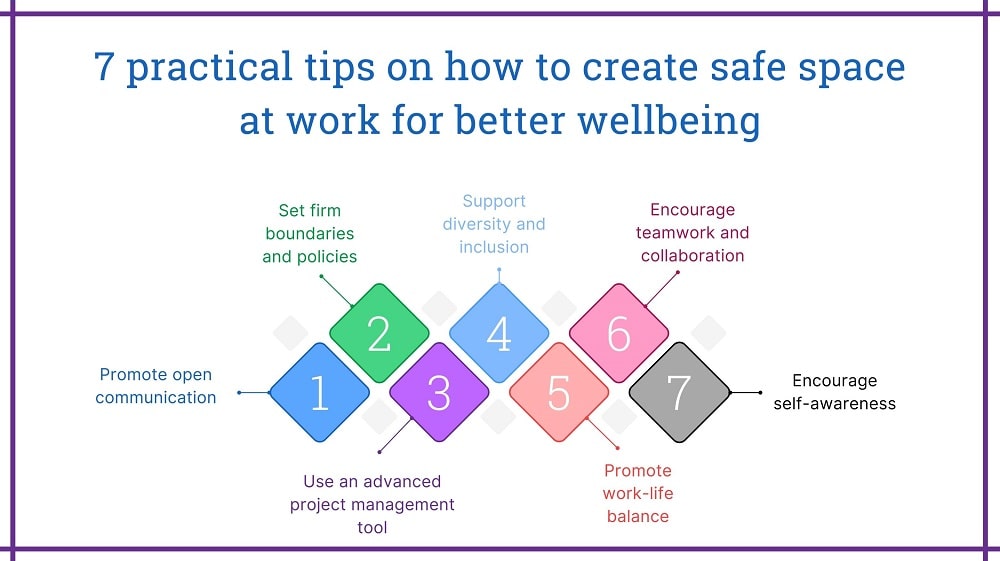According to WHO, Poor working conditions, such as discrimination and inequality, heavy workloads, lack of workplace management, and job insecurity, endanger mental health.
Do you also feel unsettled or left out in the workplace?
Creating a safe space at work is essential to developing a positive and welcoming environment for employees to work in.
However, the question is, “How to create a safe space at work?”
Unfortunately, many people face discrimination, harassment, or exclusion, which can have a negative influence on their well-being and productivity. Organizations must address these concerns and prioritize the fostering of a safe space in which everyone feels respected, valued, and empowered.
In this guide, we will look at practical tips and strategies for cultivating a work atmosphere that values trust, open communication, and mutual understanding. Let’s take a look at these strategies and see how we can actually establish a supportive and inclusive workplace.
Understanding the concept of a safe space

A psychologically safe work environment is one in which employees feel at ease, composed, and secure about their physical and mental well-being. The core component of a safe space at work is one that fosters and prioritizes employees’ well-being.
Consider a typical office environment where deadlines loom, pressure builds, and stress becomes a frequent companion. 🙇 Employees in such an environment are typically afraid to speak up, tired of judgment, criticism, or unable to take risks.
Now, let’s make this workplace a safe space ✊ – a peaceful haven where individuals may express themselves, take chances, and reach their full potential.
💪It’s a place where variety is celebrated and everyone’s views are acknowledged. Team members support and raise each other up, promoting an environment of respect and well-being. They are free to express themselves without fear of being mocked, knowing that mistakes are recognized as learning opportunities.
This is the whole crux of a safe place at work. Building an environment where employees can freely express their ideas and do work collaboratively.
Benefits of creating a safe space at work

Having a safe space is very beneficial not only for employees but for companies as well. A safe workplace is beneficial as it:
- Improves creativity🖌️ – Employees are encouraged to freely communicate their ideas in a safe work environment, which leads to greater creativity and innovation.
- Enhances Teamwork and Collaboration🤝 – A safe space encourages efficient communication and collaboration among employees by creating a friendly environment.
- Increases employee morale and engagement✊ – Employee engagement and morale skyrocket when they feel protected, appreciated, and heard, resulting in increased production and job satisfaction.
- Better mental health😇 – A safe environment promotes employees’ mental health by lowering stress and encouraging a healthier work-life balance.
- Maintains inclusion and diversity👥 – Creating a safe space fosters a culture of diversity and inclusion in which all voices are appreciated, resulting in a more rich and vibrant work environment.
This secure atmosphere fosters innovation, supports personal growth, and motivates the team to accomplish their goals.
❓But the question remains the same: Discover the ultimate tips and techniques that can genuinely assist in the creation of a situation like this. So, without further ado, have a look:
7 Practical tips on how to create safe space at work for better wellbeing

1. Promote open communication🗣️
Create an environment where everyone feels free to communicate their opinions, concerns, and ideas. Motivate team members to speak up, listen to their ideas and try to incorporate them into work.
For example, at team meetings or in real-time online discussions, let everyone contribute without fear of being judged.
👉This open communication fosters trust and psychological safety by making people feel heard and respected.
2. Set firm boundaries and policies📌
Communicate workplace regulations clearly, including recommendations on acceptable behavior, privacy, and personal limits. Give examples of what is acceptable and unacceptable behavior.
For instance, Implement a zero-tolerance policy for discrimination or harassment.
👉These defined limits contribute to a secure and courteous workplace by ensuring that everyone understands what is expected of them and what behavior will not be accepted.
3. Use an advanced project management tool⚒️
By promoting clarity, organization, and effective communication, project management tools can help to create a safe space for enhanced mental well-being in the workplace.
Clear work assignments and clear project updates create trust, eliminating misunderstandings and disagreements that can harm mental health. Furthermore, project management solutions enable teams to connect via direct chat, share files, and provide comments in a centralized and accessible platform.
👉This encourages effective teamwork, breaks down silos, and improves general contentment and well-being.
4. Support diversity and inclusion🧑🤝🧑
Celebrate and respect team members’ uniqueness, including their backgrounds, viewpoints, and experiences. Create a welcoming environment in which everybody is acknowledged and appreciated for who they are.
Organize activities or events that promote other ethnicities, religions, or traditions within the team.
👉By accepting variety, you create an environment that fosters understanding and a sense of belonging for all.
5. Promote work-life balance🏡
Help your employees achieve an appropriate balance between work and life. When possible, encourage behaviors that promote personal well-being, such as flexible work hours or remote work possibilities.
Allow staff designated time for self-care, for example, or motivate them to take breaks during the day.
👉Recognizing the significance of work-life balance demonstrates that you care about the overall well-being of your team members, which leads to higher job satisfaction and productivity.
6. Encourage teamwork and collaboration📩
Fostering collaboration and teamwork contributes to the creation of a supportive and integrated work environment. Encourage staff to collaborate, exchange ideas, and help one another grow.
Organize team-building events, collaborative tasks, or cross-departmental collaboration to foster a sense of togetherness.
👉Individuals who feel linked and supported by their coworkers are more likely to feel safe and respected at work.
7. Encourage self-awareness🙅
Encourage self-awareness in employees by giving materials and opportunities for personal reflection.
You may, for example, hold workshops or seminars on mindfulness or emotional intelligence.
👉Individuals are able to comprehend their own needs and emotions through fostering self-awareness, which may lead to a more supportive and empathic workplace environment.
Remember that creating a safe atmosphere at work is an ongoing process that requires everyone’s involvement. By applying these practical recommendations, you can develop a culture that promotes well-being and contributes to your team’s overall performance.
Conclusion
As a manager, it’s your responsibility to create a safe environment at work where trust and respect can flourish. You can empower our team members by promoting self-awareness, fostering inclusivity, supporting open communication, providing support tools, and leading by example.
Employees feel valued and supported when trust and respect are deeply ingrained in our workplace, leading to improved collaboration, creativity, and overall well-being.
Let us seize this chance to create a safe environment in which every individual may actually thrive and contribute their best.
FAQs
What is a safe space at work, and why is it important?
A safe work environment is one in which people feel comfortable expressing themselves. It is critical for creating diversity and improving general well-being.
How can leaders promote a safe space culture?
Leaders may foster a culture of safety by actively listening, appreciating multiple opinions, resolving conflicts constructively, and implementing explicit anti-discrimination policies.
What are some common challenges in creating a safe space?
Overcoming biases, managing conflicts, resolving power relations, and ensuring consistent execution of policies across the company are all common problems in creating a safe space.
How can employees contribute to building a safe space at work?
Employees can help to create a safe environment by respecting one another, demonstrating empathy, encouraging open communication, reporting any events, and participating in diversity and inclusion programs.
How can organizations measure the effectiveness of their efforts?
Organizations can review the impact of their initiatives over time by conducting surveys, gathering feedback, documenting incidents, evaluating employee engagement, and analyzing diversity and inclusion metrics.




















No Comments